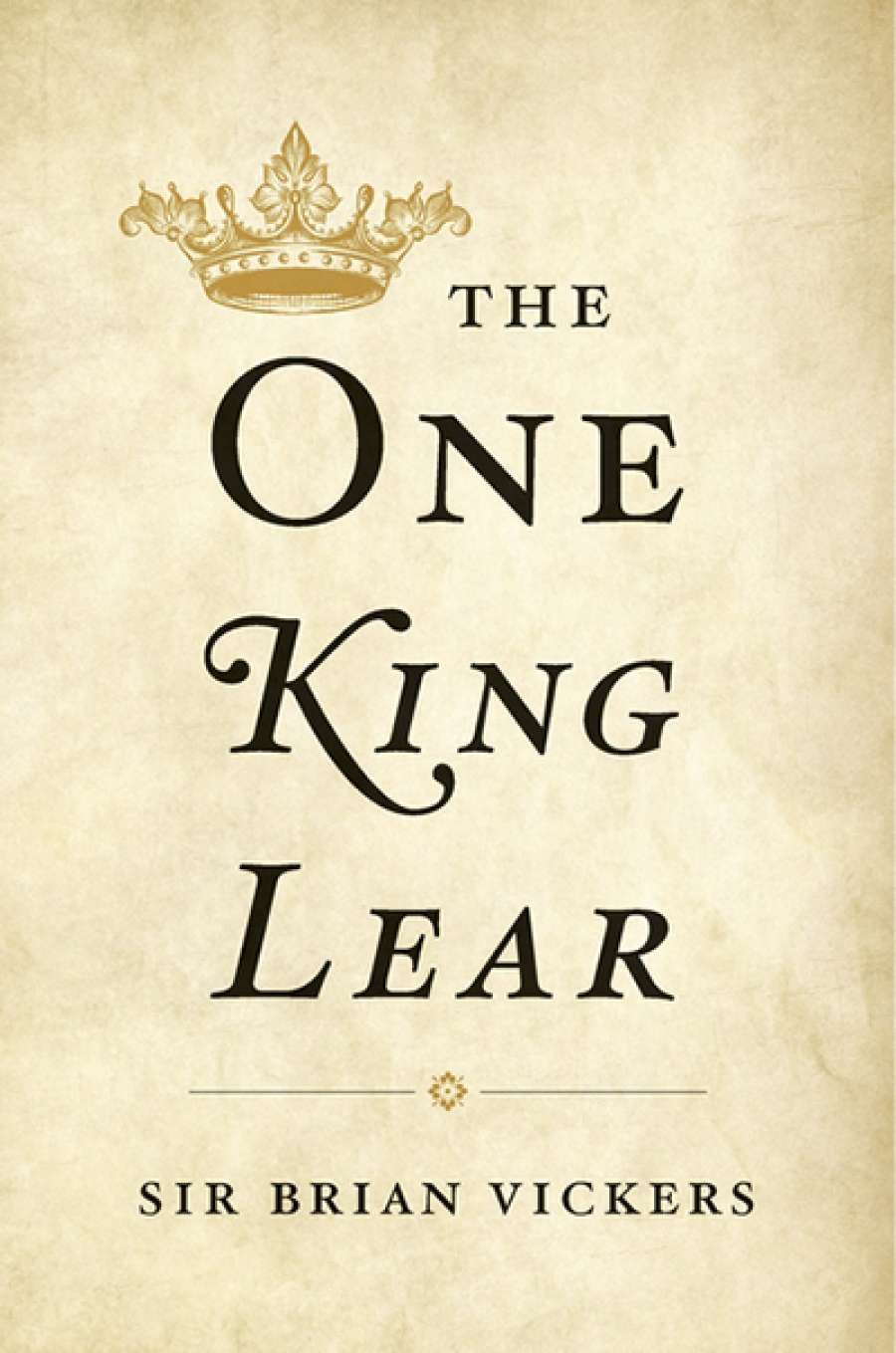
- Free Article: No
- Contents Category: Shakespeare
- Custom Article Title: David McInnis reviews 'The One King Lear' by Brian Vickers
- Review Article: Yes
- Online Only: No
- Custom Highlight Text:
Shakespeare's King Lear exists in two significantly different versions, the quarto (Q) published in 1608 and the folio (F) of 1623. Scholars typically believe that the play was ...
- Book 1 Title: The One King Lear
- Book 1 Biblio: Harvard University Press (Footprint) $84 hb, 408 pp, 9780674504844
Editors of Lear responded to these differences by conflating the two texts into an imagined 'perfect' text. In The Division of the Kingdoms: Shakespeare's two versions of King Lear (1983), Gary Taylor and Michael Warren proposed that Q and F 'preserve two separate and successive stages in the creation of King Lear'. In their view, 'far from recovering the true Shakespearian perfection in form and content', the conflated text tradition was nothing but an 'unauthoritative creation of eighteenth-century editors' and their successors. The Oxford complete works of Shakespeare, which Taylor co-edited with Stanley Wells, subsequently printed the quarto and folio texts as separate plays.
Troubled by this anti-conflation argument (which 'begs the question by assuming what it intended to prove') and irate at how 'proponents of the Two Versions thesis did not wait for a scholarly consensus to emerge, but in effect created one of their own', Brian Vickers now hopes (without a hint of irony) that his new book 'may bring about a new consensus' and 'restore King Lear to its original unity'. Despite the numerous bibliographical examples he offers, the circularity of Vickers' argument (assuming the unified Lear he intends to prove) is unlikely to convince any Two Versions scholars.
Vickers' premise is that the stationer Nicholas Okes underestimated the amount of paper (an expensive item) needed to print Lear in 1608, and consequently resorted to extreme space-saving measures. These techniques included both typographical and textual adjustments. The cumulative effect was the 'various deformations' present in Q. Vickers derides Okes for being a cheapskate, lacking in 'good workmen', and being inexperienced. Some of this scorn may be merited, but it becomes problematic when it is used to gloss over inconvenient obstacles to Vickers' argument. Noting that Okes 'gave the equivalent of six lines [of space] to his FINIS ' at the end of the quarto, Vickers offers no explanation for why a printer so desperate to save space would squander six lines, but snidely remarks: 'Modern readers might wish that he had given the text greater priority.'
 Mr. William Shakespeares Comedies, Histories, & Tragedies or The First Folio, printed by Edward Blount and Isaac Jaggard in 1623 (Schoenberg Center for Electronic Text & Image, Wikimedia Commons)Chapter two provides a lengthy discussion of other 'instance[s] of awkward space saving', illustrating that Okes was extreme in the extent of his measures. Chapter three advances the major claim that Okes's compositors (typesetters) are to blame, 'omitting more than a hundred of Shakespeare's lines'. The circularity of relying on his conclusion as premise is boldly stated when he claims that '[w]ithout the Folio as an independent witness we should never have known about the omissions Okes made'. By the end of chapter three, Vickers confidently declares that 'we can dispense with the range of theories' about the relationship between the two Lears, because they are really one, and Okes 'simply had too little paper'.
Mr. William Shakespeares Comedies, Histories, & Tragedies or The First Folio, printed by Edward Blount and Isaac Jaggard in 1623 (Schoenberg Center for Electronic Text & Image, Wikimedia Commons)Chapter two provides a lengthy discussion of other 'instance[s] of awkward space saving', illustrating that Okes was extreme in the extent of his measures. Chapter three advances the major claim that Okes's compositors (typesetters) are to blame, 'omitting more than a hundred of Shakespeare's lines'. The circularity of relying on his conclusion as premise is boldly stated when he claims that '[w]ithout the Folio as an independent witness we should never have known about the omissions Okes made'. By the end of chapter three, Vickers confidently declares that 'we can dispense with the range of theories' about the relationship between the two Lears, because they are really one, and Okes 'simply had too little paper'.
The Folio text thus becomes a 'fuller text' rather than a different text in chapter four, where Vickers offers abridgement as a putatively simpler explanation for the Q/F differences (assuming, as it does, a common ancestor for both – which has inconveniently not survived, leaving Vickers without hard evidence). Vickers asserts that the additional text in F – such as the opening scene's justification for dividing the kingdom – are not additions, but were present in 1608 and cut by 'an abridger unfamiliar with the theater'. In chapter six, Vickers accuses the King's Men of having 'mutilated a perfectly sound copy of the play' through performance cuts, making F a theatrically distorted (though importantly, not 'revised') text.
The dubious logic and polemical tone of Vickers' book hurts its argument. Furthermore, interspersed with the bibliographical details are a series of bizarre claims about 'Shakespeare's intentions', and the assertion that '[w]e know much more about the provenance of Shakespeare's plays than his fellow actors did'. Throughout, the reader is bombarded with questionable textual examples but ultimately not the 'material evidence' that Vickers, in a perplexing and scathing final chapter, accuses revisionists of lacking.


Comments powered by CComment